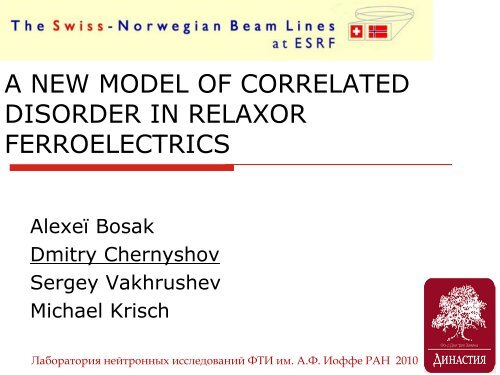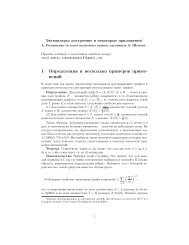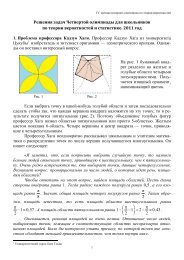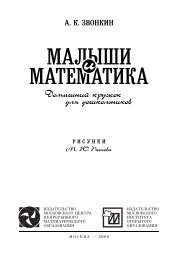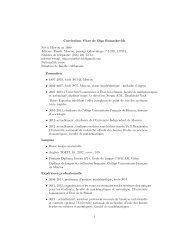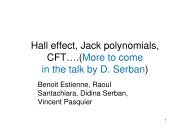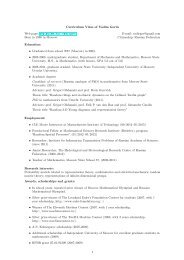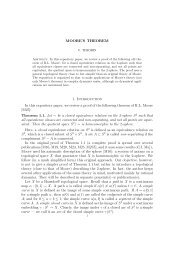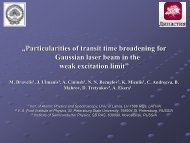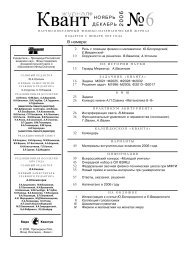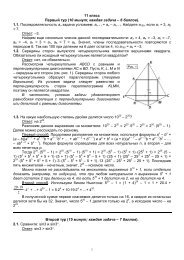a new model of correlated disorder in relaxor ferroelectrics
a new model of correlated disorder in relaxor ferroelectrics
a new model of correlated disorder in relaxor ferroelectrics
Create successful ePaper yourself
Turn your PDF publications into a flip-book with our unique Google optimized e-Paper software.
A NEW MODEL OF CORRELATED<br />
DISORDER IN RELAXOR<br />
FERROELECTRICS<br />
Alexeї Bosak<br />
Dmitry Chernyshov<br />
Sergey Vakhrushev<br />
Michael Krisch<br />
Лаборатория нейтронных исследований ФТИ им. А.Ф. Иоффе РАН 2010
Why <strong>relaxor</strong>s and diffuse scatter<strong>in</strong>g?<br />
Relaxors are <strong>in</strong>terest<strong>in</strong>g<br />
PRL 103, 207601<br />
(2009)<br />
Broad frequency-dependent peak <strong>of</strong><br />
susceptibility<br />
No change <strong>of</strong> the average structure<br />
No macroscopic polarization<br />
Relaxors are <strong>disorder</strong>ed<br />
Chemically ordered regions (COR)<br />
Static polar nano-regions (PNR)<br />
Polar glass<br />
S<strong>of</strong>t phonons<br />
Discrete breathers<br />
Disorder is challeng<strong>in</strong>g<br />
“Relaxor <strong>ferroelectrics</strong> were discovered <strong>in</strong> the<br />
1950s but many <strong>of</strong> their properties are not<br />
understood.” AiP 2011
Outl<strong>in</strong>e<br />
Diffuse scatter<strong>in</strong>g <strong>in</strong> <strong>relaxor</strong>s<br />
What do we measure - the data<br />
What do we <strong>model</strong> - PNR<br />
New parameterization<br />
Microscopic picture for <strong>new</strong> <strong>model</strong><br />
Where to move
Well known th<strong>in</strong>gs - I<br />
Diffuse scatter<strong>in</strong>g <strong>in</strong> <strong>relaxor</strong>s is<br />
well documented<br />
<strong>relaxor</strong>-specific >> Huang scatter<strong>in</strong>g >> thermal diffuse scatter<strong>in</strong>g<br />
Gehr<strong>in</strong>g et al. PRB 79, 224109 (2009)
Reported DS data<br />
1D: l<strong>in</strong>e scans<br />
2D: flat or curved reciprocal space cuts<br />
3D: not yet reported
3D mapp<strong>in</strong>g<br />
Laue time-<strong>of</strong>-flight neutron diffraction<br />
X-ray area detector data<br />
sphere<br />
space fill<strong>in</strong>g<br />
2D image
Experiment<br />
PbMg 1/3 Nb 2/3 O 3 -PbTiO 3 6%<br />
50 µm thick needle,<br />
chemically etched<br />
SNBL at ESRF / λ = 0.7Å<br />
MAR345 ImagePlate<br />
angular step 0.2 0<br />
Data analysis - CrysAlis<br />
3D maps – local s<strong>of</strong>tware<br />
Visualization – Chimera
25<br />
Well known th<strong>in</strong>gs - II<br />
Diffuse scatter<strong>in</strong>g <strong>in</strong> <strong>relaxor</strong>s<br />
serves as evidence <strong>of</strong> PNRs<br />
1. Diffuse scatter<strong>in</strong>g parameterization<br />
with shaped PRN and local polarization<br />
A. Cervell<strong>in</strong>o et al, J. Appl. Cryst. 44, 603 (2011)<br />
2. Diffuse scatter<strong>in</strong>g MC <strong>model</strong><strong>in</strong>g <strong>of</strong><br />
polar displacements<br />
M. Pasciak and T.R Welberry, 2011
3D data vs. documented PNR <strong>model</strong>s<br />
experiment<br />
ξ<br />
G(<br />
q)<br />
=<br />
1+<br />
q ξ<br />
G(<br />
q)<br />
=<br />
//<br />
2<br />
//<br />
2<br />
//<br />
ξ<br />
2<br />
⊥<br />
2 2<br />
( 1+<br />
q ξ ) 3/ 2<br />
up to 6 parameters<br />
⊥<br />
⊥<br />
ξ ξ ξ<br />
1 2 3<br />
2<br />
2<br />
( 1+<br />
( ξ ) ( ) ( ) ) 2 2<br />
1<br />
w1q<br />
+ ξ2<br />
w2q<br />
+ ξ2<br />
w3q<br />
up to 8 parameters<br />
G.Xu, Z. Zhong, H. Hiraka, G. Shirane, Phys. Rev. B 70, 174109 (2004)<br />
A. Cervell<strong>in</strong>o, S.N. Gvasaliya, O. Zaharko, B. Roessli, G.M. Rotaru, R.A. Cowley,<br />
S.G. Lushnikov, T.A. Shaplyg<strong>in</strong>a, M.-T. Fernandez-Diaz, J. Appl. Cryst. 44, 603 (2011)
1D data vs. PNR <strong>model</strong>s<br />
typically decays as ~q -2 ; never reaches q -4 ( ) ( ) ( )<br />
ξ<br />
G(<br />
q)<br />
=<br />
1+<br />
q ξ<br />
//<br />
2<br />
//<br />
2<br />
//<br />
ξ<br />
2<br />
⊥<br />
2 2<br />
( 1+<br />
q ξ ) 3/ 2<br />
⊥<br />
⊥<br />
G(<br />
q)<br />
=<br />
ξ ξ ξ<br />
1 2 3<br />
2<br />
2<br />
2<br />
( 1+<br />
ξ<br />
) 2<br />
1<br />
w1q<br />
+ ξ2<br />
w2q<br />
+ ξ2<br />
w3q<br />
I~q -2 to I~q -5 I~q -4
Compar<strong>in</strong>g 2D data…<br />
Hiraka et al.<br />
2004<br />
Xu et al.<br />
2004<br />
this work<br />
th<strong>in</strong> cut<br />
this work<br />
thick cut<br />
Welberry et al.<br />
2008<br />
Cervell<strong>in</strong>o et al.<br />
2011<br />
Vakhrushev et al.<br />
2005
Compar<strong>in</strong>g 2D data<br />
∆Q z ? misalignment thick layer? damaged surface<br />
(known)
310 node – 2D and 3D<br />
Cervell<strong>in</strong>o et al.<br />
2011<br />
this work<br />
th<strong>in</strong> cut<br />
Welberry et al.<br />
2008
Do we care about this difference?<br />
directional m<strong>in</strong>ima along τ = Q – q: not noted before<br />
asymmetry <strong>of</strong> spots out <strong>of</strong> high symmetry directions: not noted before
Incomplete <strong>in</strong>put for <strong>model</strong><strong>in</strong>g<br />
this work<br />
th<strong>in</strong> cut<br />
Xu et al.<br />
2004<br />
Cervell<strong>in</strong>o et al.<br />
2011<br />
Welberry et al.<br />
2008<br />
Paściak et al.<br />
2007<br />
Ganesh et al.<br />
2010<br />
experiment<br />
PNR<br />
“pancake”<br />
PNR<br />
“baguette”<br />
Monte-Carlo<br />
Monte-Carlo<br />
molecular<br />
dynamics<br />
directional m<strong>in</strong>ima along τ = Q – q: never predicted<br />
asymmetry <strong>of</strong> spots out <strong>of</strong> high symmetry directions: never predicted<br />
• reverse MC <strong>model</strong><strong>in</strong>g cannot reproduce features not present <strong>in</strong> the <strong>in</strong>put<br />
• exist<strong>in</strong>g phenomenological <strong>model</strong>s have poor descriptive and predictive power
20<br />
Too complex for simple <strong>model</strong>s?<br />
phenomenological PNR <strong>model</strong>s <strong>in</strong>troduce low-symmetry objects<br />
embedded <strong>in</strong> cubic matrix<br />
•3 parameters: characteristic lengths (ξ α<br />
~ 10 nm)<br />
•3 parameters: basis orientation<br />
•2 parameters: Pb displacement direction<br />
still not enough to reproduce the experimental data<br />
• Wrong q-dependence<br />
• Does not reproduce 2D maps<br />
• Wrong shape <strong>in</strong> 3D<br />
Is someth<strong>in</strong>g wrong with the structure <strong>of</strong> <strong>model</strong>s?<br />
How can one <strong>model</strong> diffuse scatter<strong>in</strong>g <strong>in</strong> <strong>relaxor</strong> without hav<strong>in</strong>g PNRs?
New parametrization<br />
h<strong>in</strong>t: use the analogy with thermal diffuse scatter<strong>in</strong>g<br />
average symmetry: cubic<br />
Pb position: delocalized over sphere<br />
2<br />
2<br />
s<strong>in</strong> (2πr0<br />
Q)<br />
T −1<br />
I ∝ f<br />
Pb(Q)exp(-2WPb(Q))<br />
⋅Q<br />
⋅ Σ(<br />
Q)<br />
⋅Q<br />
2<br />
Q<br />
Σ<br />
Σ<br />
Σ<br />
pc<br />
fcc<br />
( Q)<br />
= (1 − µ ) Σ ( Q)<br />
+ Σ ( Q)<br />
αα αα<br />
µ<br />
pc<br />
αα<br />
fcc<br />
αα<br />
Σαβ<br />
( Q)<br />
= ( Ψ44 + Ψ12<br />
)s<strong>in</strong>(2πQα<br />
)s<strong>in</strong>(2πQ<br />
β<br />
Ψijkl<br />
αα<br />
( Q)<br />
= 2Ψ<br />
(1 − cos(2πQα<br />
)) + 2Ψ44<br />
(2 − cos(2πQ<br />
) − cos(2πQ<br />
11 β<br />
γ<br />
( Q)<br />
= Ψ (2 − cos(2πQα<br />
)(cos(2πQ<br />
β<br />
) + cos(2πQγ<br />
))) + (2Ψ44<br />
− Ψ12<br />
))<br />
)(1 − cos(2πQ<br />
)cos(2πQ<br />
11 β<br />
γ<br />
is <strong>of</strong> cubic symmetry: 3 <strong>in</strong>variants<br />
Ψ is not elastic tensor<br />
)<br />
analogy with D(Q)<br />
for monoatomic lattice<br />
))<br />
2 adjustable parameters: i.e. Ψ 11<br />
/Ψ 12<br />
and Ψ 11<br />
/Ψ 44<br />
; large q: adjustable µ<br />
for the prototype formulae see A. Bosak, D. Chernyshov, Acta Cryst. A 64, 598 (2008)
New parametrization: 2D<br />
artifacts due<br />
to the fake<br />
FCC structure<br />
shape <strong>in</strong> the proximity <strong>of</strong> nodes: reproduced<br />
decay: automatically q -2<br />
relative <strong>in</strong>tensities <strong>of</strong> spots: qualitatively reproduced
New parametrization: 2D<br />
µ = 0.95<br />
shape <strong>in</strong> the proximity <strong>of</strong> nodes: reproduced<br />
decay: automatically q -2<br />
relative <strong>in</strong>tensities <strong>of</strong> spots: qualitatively reproduced
New parametrization: 3D<br />
experiment<br />
PNR-related<br />
<strong>model</strong>s
New parametrization: 3D<br />
experiment<br />
<strong>new</strong> <strong>model</strong><br />
PNR-related<br />
<strong>model</strong>s
Reconcil<strong>in</strong>g with the old data<br />
Ψ 12 <strong>in</strong>creased by 20%<br />
vs. PMN-PT<br />
no artificial low-symmetry<br />
entities are <strong>in</strong>troduced<br />
cubic symmetry only<br />
experimental data for PZN-PT:<br />
G.Xu, Z. Zhong, H. Hiraka, G. Shirane,<br />
Phys. Rev. B 70, 174109 (2004)
Laue TOF vs. X-ray scatter<strong>in</strong>g<br />
ma<strong>in</strong> features <strong>of</strong> Laue TOF<br />
pattern are reproduced when<br />
the <strong>in</strong>tegration layer thickness<br />
<strong>of</strong> ±0.15-0.2 r.l.u. is taken<br />
T.R. Welberry, Metallurgical and Materials Transactions A, 39A, 3170 (2008)
More than description…<br />
2 parameter TDS-like formalism<br />
reproduces experimental 1D, 2D, and<br />
3D data better than any PNR <strong>model</strong>s<br />
Parametric <strong>model</strong> could be used for<br />
structure-property correlations<br />
It also has a predictive power – what<br />
would be under electric field?
Electric field effect<br />
experimental data for PZN-PT:<br />
G. Xu, Z. Zhong, Y. B<strong>in</strong>g,<br />
Z.-G. Ye, G. Shirane,<br />
Nature Materials 5, 134 (2006)<br />
field applied along <br />
<strong>in</strong>tensity redistribution and<br />
pattern symmetry lower<strong>in</strong>g is<br />
reproduced by replac<strong>in</strong>g the<br />
uniform distribution <strong>of</strong> Pb<br />
displacements over sphere by<br />
ellipsoid-like distribution<br />
with 1 parameter<br />
exp <strong>model</strong>
Pleasant surprise<br />
MS30.P08(C417) | B.A. Frandsen: Quantitative <strong>model</strong><strong>in</strong>g <strong>of</strong><br />
diffuse scatter<strong>in</strong>g from a <strong>relaxor</strong> ferroelectric<br />
- 3D reconstructions from CCD<br />
images<br />
- similar low-q formalism, based<br />
on purely cubic symmetry
10<br />
If no polar doma<strong>in</strong>s – than what?<br />
?<br />
Parameterization can be used to generate<br />
real space structure with required<br />
correlation properties<br />
Ψ R(Q)<br />
11 /Ψ 12 and Ψ 11 /Ψ 44<br />
<br />
U(Q)<br />
<br />
P i<br />
(as before we consider only lead subattice)
Real space <strong>model</strong>: concept at work<br />
<br />
<br />
cluster 64 3 was populated by 3*64 3 waves with random phases<br />
and appropriate amplitudes<br />
all local displacements were normalized to the radius <strong>of</strong> Pb<br />
sphere (e.g. 0.08a)<br />
cut <strong>of</strong> real space cluster<br />
x component<br />
HK0 scatter<strong>in</strong>g from cluster<br />
decay as q -2
Real space <strong>model</strong>: concept does work<br />
<br />
4 clusters generated + Laue averag<strong>in</strong>g (x48)<br />
experimental scatter<strong>in</strong>g can<br />
be reproduced by Pb<br />
displacement pattern<br />
without <strong>in</strong>troduc<strong>in</strong>g PNRs<br />
microscopic <strong>model</strong>!
Real space <strong>model</strong>: displacement pattern<br />
100 nm<br />
0<br />
fcc-like <strong>model</strong><br />
primitive cubic <strong>model</strong>
Real space <strong>model</strong>: displacement pattern<br />
mixed <strong>model</strong><br />
R ( Q)<br />
= µ R ( Q)<br />
+ (1 − µ ) R ( Q)<br />
mixed<br />
fcc<br />
pc
10<br />
Local polarisation<br />
fcc‐like <strong>model</strong><br />
primitive cubic<br />
Us<strong>in</strong>g 2D 93 Nb NMR, the probability distribution <strong>of</strong> local polarization <strong>in</strong> PMN is found to be<br />
Gaussian<br />
[R. Bl<strong>in</strong>c, J. Dol<strong>in</strong>šek, A. Gregorovič, B. Zalar, C. Filipič, Z. Kutnjak, A. Levstik, and R. Pirc, Phys. Rev. Lett. 83, 424<br />
(1999)]
Microscopic <strong>model</strong> beh<strong>in</strong>d<br />
<br />
The set <strong>of</strong> possible positions <strong>of</strong> Pb is very large and can be<br />
approximated by a spherical shell<br />
Pb ions <strong>in</strong>teract essentially via the BO 3<br />
octahedral framework; they can be aligned<br />
by a dynamical local distortion - phonon<br />
with sufficient amplitude and proper<br />
polarization<br />
<br />
The probability <strong>of</strong> switch<strong>in</strong>g is therefore<br />
<strong>in</strong>versely proportional to the frequency<br />
golf ball<br />
U.S. Patent 4,560,168<br />
<strong>of</strong> the wave (~ω -2 for ħω
Relaxor-specific component <strong>of</strong> diffuse scatter<strong>in</strong>g (RSDS) should disappear<br />
at high temperature as Pb displacements will become a free un<strong>correlated</strong><br />
movement over the spherical shell<br />
RSDS should disappear under high pressure as Pb ions will be<br />
immobilised <strong>in</strong> the emerg<strong>in</strong>g local m<strong>in</strong>ima on the sphere<br />
RSDS should deform <strong>in</strong> an applied electric field as Pb ions as additional<br />
anisotropy will be created over the displacement shell; features<br />
perpendicular to the field direction should shr<strong>in</strong>k<br />
The naturally created hierarchy <strong>of</strong> displacement patterns <strong>in</strong> space and<br />
their respective lifetimes should result <strong>in</strong> the large spread <strong>of</strong> relaxation<br />
times<br />
The uniform slow fad<strong>in</strong>g <strong>of</strong> polarization <strong>in</strong> switched doma<strong>in</strong> without wall<br />
movement is also <strong>in</strong> l<strong>in</strong>e with our concept.
X<br />
<br />
<br />
<br />
<br />
Relaxor-specific component <strong>of</strong> diffuse scatter<strong>in</strong>g (RSDS) should disappear<br />
at high temperature as Pb displacements will become a free un<strong>correlated</strong><br />
movement over the spherical shell<br />
RSDS should disappear under high pressure as Pb ions will be<br />
immobilised <strong>in</strong> the emerg<strong>in</strong>g local m<strong>in</strong>ima on the sphere<br />
RSDS should deform <strong>in</strong> an applied electric field as Pb ions as additional<br />
anisotropy will be created over the displacement shell; features<br />
perpendicular to the field direction should shr<strong>in</strong>k<br />
The naturally created hierarchy <strong>of</strong> displacement patterns <strong>in</strong> space and<br />
their respective lifetimes should result <strong>in</strong> the large spread <strong>of</strong> relaxation<br />
times<br />
The uniform slow fad<strong>in</strong>g <strong>of</strong> polarization <strong>in</strong> switched doma<strong>in</strong> without wall<br />
movement is also <strong>in</strong> l<strong>in</strong>e with our concept.<br />
H. Hiraka, S.-H. Lee, P.M. Gehr<strong>in</strong>g, G. Xu, G. Shirane, Phys. Rev. B 70, 184105 (2004)
X<br />
X<br />
<br />
<br />
<br />
Relaxor-specific component <strong>of</strong> diffuse scatter<strong>in</strong>g (RSDS) should disappear<br />
at high temperature as Pb displacements will become a free un<strong>correlated</strong><br />
movement over the spherical shell<br />
RSDS should disappear under high pressure as Pb ions will be<br />
immobilised <strong>in</strong> the emerg<strong>in</strong>g local m<strong>in</strong>ima on the sphere<br />
RSDS should deform <strong>in</strong> an applied electric field as Pb ions as additional<br />
anisotropy will be created over the displacement shell; features<br />
perpendicular to the field direction should shr<strong>in</strong>k<br />
The naturally created hierarchy <strong>of</strong> displacement patterns <strong>in</strong> space and<br />
their respective lifetimes should result <strong>in</strong> the large spread <strong>of</strong> relaxation<br />
times<br />
The uniform slow fad<strong>in</strong>g <strong>of</strong> polarization <strong>in</strong> switched doma<strong>in</strong> without wall<br />
movement is also <strong>in</strong> l<strong>in</strong>e with our concept.<br />
J. Kreisel, P. Bouvier, B. Dkhil, B. Chaabane, A. Glazer, P. Thomas, T. Welberry, Ferroelectrics<br />
302, 293 (2004)
X<br />
X<br />
X<br />
<br />
<br />
Relaxor-specific component <strong>of</strong> diffuse scatter<strong>in</strong>g (RSDS) should disappear<br />
at high temperature as Pb displacements will become a free un<strong>correlated</strong><br />
movement over the spherical shell<br />
RSDS should disappear under high pressure as Pb ions will be<br />
immobilised <strong>in</strong> the emerg<strong>in</strong>g local m<strong>in</strong>ima on the sphere<br />
RSDS should deform <strong>in</strong> an applied electric field as Pb ions as additional<br />
anisotropy will be created over the displacement shell; features<br />
perpendicular to the field direction should shr<strong>in</strong>k<br />
The naturally created hierarchy <strong>of</strong> displacement patterns <strong>in</strong> space and<br />
their respective lifetimes should result <strong>in</strong> the large spread <strong>of</strong> relaxation<br />
times<br />
The uniform slow fad<strong>in</strong>g <strong>of</strong> polarization <strong>in</strong> switched doma<strong>in</strong> without wall<br />
movement is also <strong>in</strong> l<strong>in</strong>e with our concept.<br />
G. Xu, Z. Zhong, Y. B<strong>in</strong>g, , Z.-G. Ye, G. Shirane, Nature Materials 5, 134 (2006)<br />
S.B. Vakhrushev, A.A. Naberezhnov, N.M. Okuneva, B.N. Savenko, Phys. Solid State 40, 1728 (1998)
X<br />
X<br />
X<br />
X<br />
<br />
Relaxor-specific component <strong>of</strong> diffuse scatter<strong>in</strong>g (RSDS) should disappear<br />
at high temperature as Pb displacements will become a free un<strong>correlated</strong><br />
movement over the spherical shell<br />
RSDS should disappear under high pressure as Pb ions will be<br />
immobilised <strong>in</strong> the emerg<strong>in</strong>g local m<strong>in</strong>ima on the sphere<br />
RSDS should deform <strong>in</strong> an applied electric field as Pb ions as additional<br />
anisotropy will be created over the displacement shell; features<br />
perpendicular to the field direction should shr<strong>in</strong>k<br />
The naturally created hierarchy <strong>of</strong> displacement patterns <strong>in</strong> space and<br />
their respective lifetimes should result <strong>in</strong> the large spread <strong>of</strong> relaxation<br />
times<br />
The uniform slow fad<strong>in</strong>g <strong>of</strong> polarization <strong>in</strong> switched doma<strong>in</strong> without wall<br />
movement is also <strong>in</strong> l<strong>in</strong>e with our concept.<br />
D. Viehland, S.J. Jang, L.E. Cross, M. Wutt<strong>in</strong>g, J. Appl. Phys. 68, 2916 (1990)
X<br />
X<br />
X<br />
X<br />
X<br />
Relaxor-specific component <strong>of</strong> diffuse scatter<strong>in</strong>g (RSDS) should disappear<br />
at high temperature as Pb displacements will become a free un<strong>correlated</strong><br />
movement over the spherical shell<br />
RSDS should disappear under high pressure as Pb ions will be<br />
immobilised <strong>in</strong> the emerg<strong>in</strong>g local m<strong>in</strong>ima on the sphere<br />
RSDS should deform <strong>in</strong> an applied electric field as an additional<br />
anisotropy will be created over the displacement shell; features<br />
perpendicular to the field direction should shr<strong>in</strong>k<br />
The naturally created hierarchy <strong>of</strong> displacement patterns <strong>in</strong> space and<br />
their respective lifetimes should result <strong>in</strong> the large spread <strong>of</strong> relaxation<br />
times<br />
The uniform slow fad<strong>in</strong>g <strong>of</strong> polarization <strong>in</strong> switched doma<strong>in</strong> without wall<br />
movement is also <strong>in</strong> l<strong>in</strong>e with our concept.<br />
A. Kholk<strong>in</strong>, A. Morozovska, D. Kiselev, I. Bdik<strong>in</strong>, B. Rodriguez, P. Wu, A. Bokov, Z.-G. Ye, B.<br />
Dkhil, L.-Q. Chen, M. Kosec, S.V. Kal<strong>in</strong><strong>in</strong>, Adv. Functional Materials 21, 1977 (2011)
Conclusions I<br />
<br />
<br />
<br />
<br />
The characteristic diffuse scatter<strong>in</strong>g <strong>in</strong> Pbconta<strong>in</strong><strong>in</strong>g<br />
<strong>relaxor</strong>s is <strong>in</strong>compatible with<br />
any proposed static PNR <strong>model</strong>s (ξ α<br />
~ 10<br />
nm)<br />
We suggest a phenomenological pseudo-<br />
TDS <strong>model</strong> with a m<strong>in</strong>imal number <strong>of</strong><br />
adjustable parameters (2 to 3) and<br />
keep<strong>in</strong>g average cubic symmetry<br />
Proposed <strong>model</strong> even <strong>in</strong> the current very<br />
simple form fits much better available<br />
experimental data<br />
Correspond<strong>in</strong>g real space realization is a<br />
superposition <strong>of</strong> displacements - at<br />
variance with a distribution <strong>of</strong> polar<br />
doma<strong>in</strong>s.
Conclusions II<br />
Diffuse clouds <strong>of</strong> complex 3D shape require<br />
3D real-space <strong>model</strong>s<br />
Special care has to be taken about effects<br />
distort<strong>in</strong>g 2D images (geometrical<br />
correction, orientation matrix, thickness <strong>of</strong><br />
reciprocal layers …)<br />
Often there is a volume <strong>of</strong> good old data on<br />
1D q-dependences – should not be ignored.<br />
If a <strong>disorder</strong>ed structure affects the<br />
properties – the <strong>model</strong> has to be compatible<br />
with physical properties.
Where to move<br />
<br />
<br />
More realistic <strong>model</strong><strong>in</strong>g - with all atoms <strong>in</strong> the unit cell.<br />
From statistical properties <strong>of</strong> real space realizations to physical<br />
properties.<br />
<br />
<br />
<br />
Why the decay is sometimes a bit faster than q -2 ? Is it related<br />
to the attraction/repulsion poles on the Pb-locus sphere?<br />
Does Pb pattern results from normal phonon population, or it<br />
resembles the mechanism <strong>of</strong> “rogue waves” creation? Or nonl<strong>in</strong>ear<br />
discrete breathers? Or critical fluctuations?<br />
And what happens <strong>in</strong> lead-free <strong>relaxor</strong>s?
Acknowledgments<br />
Efim Kats<br />
Institut Laue-Langev<strong>in</strong>, Grenoble, France<br />
Björn W<strong>in</strong>kler<br />
Goethe-Universität, Frankfurt a.M., Germany<br />
Thank you for your attention!<br />
http://lanl.arxiv.org/abs/1101.0490<br />
Acta Crystallographica A, 2011 впечати


